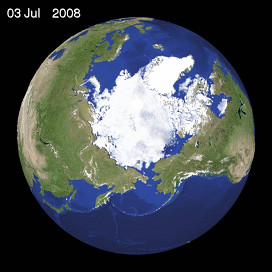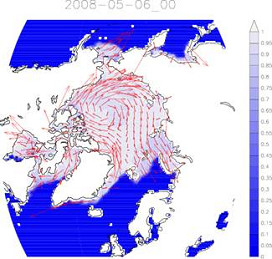2008.07.25
Aiming for the Realization of Polar Routeing
Monitoring, Analyzing and Forecasting Sea Ice in the Arctic Ocean at the Weathernews Global Ice Center
On July 1, 2008, Minato-ku, Tokyo-based Weathernews Inc. (Hereinafter Weathernews; President: Chihito Kusabiraki) opened a Global Ice Center at its Global Center in Makuhari, Chiba. The purpose of the Global Ice Center is to collect and analyze global ice data, especially that of the Polar Regions. As global warming continues to cause the polar ice coverage to shrink, the Polar Regions have begun to be regarded as a feasible area for economic activities. It is also believed that the Polar Route has become a real possibility for maritime shipping. At the Global Ice Center, Weathernews collects and monitors global sea ice data in order to grasp the ice conditions across the world, and has plans to support safe passage for shipping vessels across the North Pole.

With the relization of Porlar Routeing, both time and fuel can be saved, when compared to present routes.
For over twenty years, Weathernews, the world’s largest full-service weather company, has been observing, analyzing and forecasting all meteorological phenomena over the sea, air and land, 24 hours a day, 365 days a year, with a staff of over 600 professionals. Weathernews provides optimized marine weather information to improve safety and planning to over 7,000 vessels across the globe, through its unique Voyage Planning Service
Weathernews has worked closely with maritime companies and experts in the field of sea ice to determine the present conditions and issues to be resolved in order to realize Polar Routeing, a truly revolutionary concept for the 21st century. During this process, many opinions were voiced, such as: “The Northern Sea Route will become feasible in the very near future,” and “One of the biggest issues is to determine how to solve the problem of dealing with sea ice, in order to help vessels safely navigate the Arctic Ocean. Is there not some way to always be aware of the distribution of the sea ice in the region?” With such opinions being exchanged, Weathernews realized that a full grasp of the situation of sea ice, which is an obstacle to vessel passage and could also damage the vessels, as well as services to ensure safe passage of the vessels, was an urgent mission and created the Global Ice Center, gathering global sea ice information, especially that of the Arctic Ocean, and has as one of its functions a continuous monitoring of the global sea ice distribution.
[Functions of the Global Ice Center]

Ice conditions over the Arctic Ocean, as analyzed by the Global Ice canter.
1. Sea Ice Analysis through Satellite Technology
The Weathernews Global Ice Center is poised to monitor the situation of global sea ice, especially that of the Arctic Ocean, via polar orbiting satellites, analyze the data and provide global, unified sea ice content to maritime companies.
In addition, in the year 2010, Weathernews has plans to launch our own satellite, the “Polar Router,” as a unique Eye-Servation※ device. The satellite will be equipped with a visible infrared / near infrared camera in order to perform in-house monitoring of sea ice. By then also including Eye-Servation information provided by ship captains across the world, Weathernews will revise and update its sea ice information as necessary, and use this two-way network to improve the quality of sea ice information available.
※Eye-Servation is a term unique to Weathernews. “Eye-Servation” is not merely the collection of facts, but also includes the way the person or machine “feels” at the time.

Forecasting Sea Ice with the I-See-Eengine
2. Original Sea Ice Forecast System “I-See-Engine”
At the Weathernews Global Ice Center, our unique sea ice analysis and forecast system, the “I-See-Engine,” is used to create forecasts of sea ice distribution out to two weeks. Based on marine weather elements such as sea surface temperature and sea currents, as well as observations of the ice, the “I-See-Engine” is comprised of a dynamic model which looks at the processes of movement, convergence and divergence of sea ice, as well as a thermodynamic model which looks at the processes of freezing and melting of sea ice. With this system, a two-week forecast of sea ice density and thickness, as well as its movement, is being planned.
[The Future of the Global Ice Center]
1. Improved Support for the Shipping Industry
At Weathernews, we plan on providing full support to maritime companies who attempt to send test vessels to navigate the Polar Routes. We believe that with the sea ice information provided by our Global Ice Center, we can contribute to the safe passage of these vessels that brave the icy waters of the Arctic Ocean.
2. Monitoring Global Warming through Sea Ice
Last year, the surface area of sea ice in the Arctic Ocean was the smallest ever recorded since the beginning of official scientific observations. The Global Ice Center will continuously monitor the increase or decrease in the sea ice in the Arctic Ocean, through this, we believe that we will be able to monitor the situation of global warming via the index of sea ice distribution.
3. Increased Public Awareness about Sea Ice
The Global Ice Center has plans to work closely with sea ice experts from Tokyo University, Chiba University and other institutions, to provide more accurate sea ice data. It is our hope to increase the knowledge base regarding sea ice in the Polar Regions with these parties, including interested members of the general public.
At Weathernews, use our experience in providing optimum routeing support services for over one million voyages, as the basis to support all maritime companies who strive for total optimization of their operations. We also expect that the Weathernews Global Ice Center, through its constant monitoring of the increases and decreases of sea ice in the North Pole, will become a herald in understanding changes in our climate.

